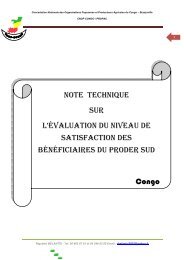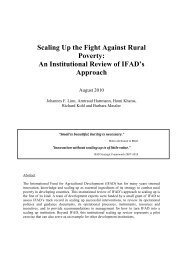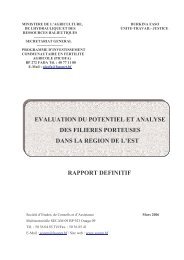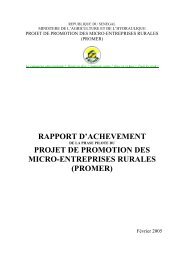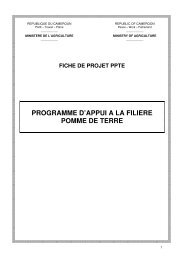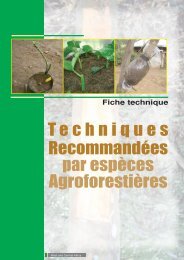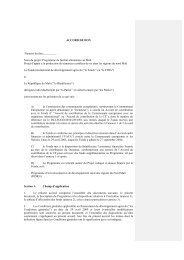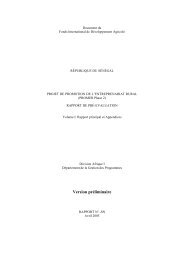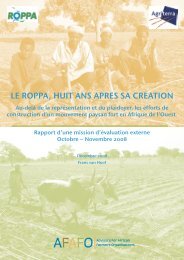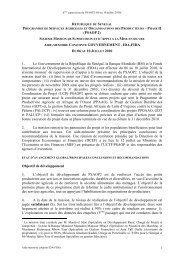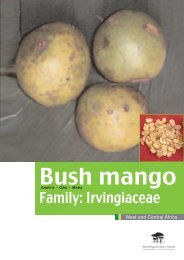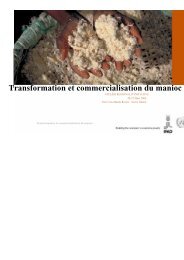CASSAVA OPPORTUNTIES IN NIGERIA - FAO.org
CASSAVA OPPORTUNTIES IN NIGERIA - FAO.org
CASSAVA OPPORTUNTIES IN NIGERIA - FAO.org
You also want an ePaper? Increase the reach of your titles
YUMPU automatically turns print PDFs into web optimized ePapers that Google loves.
Secondly, a project sponsored by the Department<br />
of International Development (DFID) – United<br />
Kingdom and now the European Union (EU) with<br />
NRI and the University of Agriculture Abeokuta<br />
(UNAAB) on the commercialization of traditional<br />
processed products from cassava, such as wet<br />
fufu and dried fufu has proven to be a successful<br />
initiative in South West Nigeria. This initiative has<br />
the potential to offer new opportunities to rural<br />
households – either through the sale of fresh roots<br />
or through processing and marketing. Several<br />
options exist for the commercialization of fufu,<br />
including the production of a shelf-stable product.<br />
At the rural level, processors have demonstrated<br />
their ability to adopt low-tech, low cost<br />
improvements to processing such as the<br />
construction and use of water tanks and “double<br />
fermentation”. A processing technology has also<br />
been developed for village level production of<br />
dried fufu flour using a simple drier that can<br />
operate in areas with or without electricity.<br />
The fabrication of user-friendly equipment for<br />
cassava processing in Nigeria is also witnessing<br />
renewed interest. Since 1970, the Federal<br />
Institute of Industrial Research Osodi, FIIRO, has<br />
provided a processing plant for the mechanization<br />
of cassava gari. National, regional and private<br />
fabricating centres have also demonstrated new<br />
processing equipment such as mobile graters,<br />
modified fryers, dryers and millers. Data on the<br />
adoption rate of this equipment, however, remains<br />
scarce.<br />
As part of the IITA Cassava Mosaic Disease<br />
(CMD) project, an initiative has been put forward<br />
for the collection of needed data on processing<br />
technologies and equipment. Benchmarks are<br />
needed to measure the progress of the cassava<br />
industry in the years to come. It is known that<br />
small-scale operators using low level technologies<br />
do process, but their needs, capacity or the<br />
intended benefit from moving to higher levels of<br />
technology are not known. This IITA CMD project<br />
survey will hopefully answer these questions and<br />
develop targets for future research and<br />
development in cassava processing and<br />
utilization. For example, technologies targeted to<br />
peeling may have implications on breeding of new<br />
cassava varieties.<br />
15<br />
An important initiative was started in September of<br />
2003 when a meeting of manufactures of textiles<br />
and producers of cassava starch was <strong>org</strong>anized.<br />
These types of dialogues are necessary and<br />
strongly recommended. The position put forward<br />
by the textile manufacturers was that corn starch<br />
is better than cassava starch and since Nigeria<br />
does not produce corn starch it should be allowed<br />
to import it. The key constraints identified by the<br />
textile representatives were the high moisture<br />
content of cassava starch above 13 percent, poor<br />
packaging, irregular supplies, high prices<br />
compared to imported corn starch, and<br />
unacceptable pH levels and values. The<br />
response from the cassava starch manufacturers<br />
was to suspect micro to small scale starch plants<br />
for the low standards and low starch purity levels.<br />
It was further explained, that the problems caused<br />
by low quality standards could be easily solved by<br />
patronage of medium to large starch plants. This<br />
response by the starch manufacturers is less than<br />
satisfactory and seems more like an attempt to<br />
shift blame and obtain new business. Instead an<br />
enquiry should have been suggested to determine<br />
where the textile firms were purchasing their<br />
cassava starch and what measures can be put in<br />
place to guarantee the desired product and<br />
delivery regardless of whether the supplier was a<br />
small, medium or large cassava starch<br />
manufacturer.<br />
Other processing research initiatives currently<br />
underway include developing a thin-skinned<br />
cassava that would remain unpeeled, dried and<br />
used in poultry animal feeds. By leaving the thin<br />
skin on it increases the conversion rate but also<br />
increases the fibre content of the feed 16 . Use of a<br />
yellow cassava in poultry feed is also being<br />
investigated as a positive contributor to making<br />
yolks more yellow and higher in nutrition.<br />
Finally although the new Federal Food Reserve<br />
Scheme has earmarked the collection of gari from<br />
various zones, implementation to date has been<br />
poor.<br />
16 In addition to this research, livestock feeding practices<br />
should also be investigated to see if placing the water in<br />
containers above the birds would lessen the caking of the<br />
cassava flour around the bird’s beaks.



